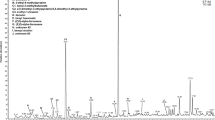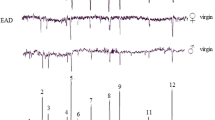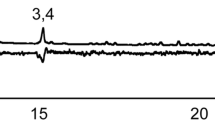Abstract
We have identified five compounds from the headspace of calling male Mediterranean fruit flies (medfly),Ceratitis capitata (Wiedemann), and three compounds from the headspace of ripe mango (Mangifera indica L). using coupled gas chromatographic-electroantennographic (GC-EAG) recordings, coupled gas chromatographic-mass spectrometric (GC-MS) analysis, and electroantennographic (EAG) assays of standards. The male-produced volatiles eliciting responses from female antennae were ethyl-(E)-3-octenoate, geranyl acetate, (E,E)-α-farnesene, linalool, and indole. An EAG dose-response test of linalool enantiomers and indole with female medfly antennae showed relatively strong EAG activities, but no significant difference between (R)-(-)-linalool and (S)-(+)-linalool. The three mango volatiles were identified as (1S)-(-)-β-pinene, ethyl octanoate, andβ-caryophyllene. In addition, a strong antennal response was recorded from a contaminant,α-copaene, present in a commercial sample ofβ-caryophyllene. The EAG response amplitudes from both male and female antennae to the above three mango volatiles were significantly greater than to a hexanol control. For both male and female medfly antennae, the greatest EAG responses were elicited byβ-caryophyllene followed by ethyl octanoate. The mean EAG responses of female antennae toβ-caryophyllene and (1S)-(-)-β-pinene were significantly greater than those of male antennae.
Similar content being viewed by others
References
Baker, P.S., Howse, P.E., Ondarza, R.N., andReyes, J. 1990. Field trials of synthetic sex pheromone components of the male Mediterranean fruit fly (Diptera: Tephritidae) in southern Mexico.J. Econ. Entomol. 83:2235–2245.
Baker, R.R., Herbert, R.H., andGrant, G.G. 1985. Isolation and identification of the sex pheromone of the Mediterranean fruit fly,Ceratitis capitata (Wied.).J. Chem. Soc. Chem. Commun. 1985:824–825.
Baker, T.C., Francke, W., Millar, J.G., Löfstedt, C., Hansson, B., Du, J.-W. Phelan, P.L., Vetter, R.S., Youngman, R., andTodd, J.L. 1991. Identification and bioassay of sex pheromone components of the carob moth,Ectomyelois ceratoniae (Zeller).J. Chem. Ecol. 17:1973–1988.
Bartley, J.P. 1988. Volatile flavours of Australian tropical fruits.Biomed. Environ. Mass Spectrom. 16:201–205.
Bartley, J.P., andSchwede, A. 1987. Volatile flavor components in the headspace of the Australian or “Bowen” mango.J. Food Sci. 52:353–355.
Beroza, M., andGreen, N. 1963. Materials tested as insect attractants. USDA Agricultural Handbook No. 536, 119 pp.
Beroza, M., Green, N., Gertler, S.I., Steiner, L.F., andMiyashita, D.H. 1961. Insect attractants. New attractants for the Mediterranean fruit fly.J. Agric. Food Chem. 9:361–365.
Engel, K.H., andTressl, R. 1983. Studies on the volatile components of two mango varieties.J. Agric. Food Chem. 31:796–801.
Flath, R.A., Jang, E.B., Light, D.M., Mon, R.T., Carvalho, L., Binder, R.G., andJohn, J.O. 1993. Volatile pheromonal emissions from the Mediterranean fruit fly: Effects of fly age and time of day.J. Agric. Food Chem. 41:830–837.
Flath, R.A., Cunningham, R.T., Mon, T.R., andJohn, J.O. 1994a. Additional male Mediterranean fruitfly (Ceratitis capitata Wied.) attractants from angelica seed oil (Angelica archangelica L.).J. Chem. Ecol. 20:1969–1984.
Flath, R.A., Cunningham, R.T., Mon, T.R., andJohn, J.O. 1994b. Male lures for Mediterranean fruitfly (Ceratitis capitata Wied.): Structural analogs ofα-copaene.J. Chem. Ecol. 20:2595–2609.
Hagen, K.S., Allen, W.W., andTasson, R.L. 1981. Mediterranean fruit fly: The worst is yet to come.Calif. Agric. 35:5–7.
Heath, R.R., Landolt, P.J., Tumlinson, J.H., Chambers, D.L., Murphy, R.E., Doolittle, R.E., Dueben, B.D., Sivinski, J., andCalkins, C.O. 1991. Analysis, synthesis, formulation, and field testing of three major components of male Mediterranean fruit fly pheromone.J. Chem. Ecol. 17:1925–1940.
Jang, E.B., Light, D.M., Flath, R.A., Nagata, J.T., andMon, T.R. 1989. Electroantennogram responses of the Mediterranean fruit fly,Ceratitis capitata, to identified volatile constituents from calling males.Entomol. Exp. Appl. 50:7–19.
Jang, E.B., Light, D.M., Binder, R.G., Flath, R.A., andCarvalho, L.A. 1994. Attraction of female Mediterranean fruit flies to the five major components of male-produced pheromone in a laboratory flight tunnel.J. Chem. Ecol. 20:9–20.
Landolt, P.J., Heath, R.R., andChambers, D.L. 1992a. Oriented flight responses of female Mediterranean fruit flies to calling males, odor of calling males, and a synthetic pheromone blend.Entomol. Exp. Appl. 65:259–266.
Landolt, P.J., Reed, H.C., andHeath, R.R. 1992b. Attraction of female papaya fruit fly (Diptera: Tephritidae) to male pheromone and host fruit.Environ. Entomol. 21:1154–1159.
Landolt, P.J., Heath, R.R., Millar, J.G., Davis-Hernandez, K.M., Dueben, B.D., andWard, K.E. 1994. Effects of host plant,Gossypium hirsutum L., on sexual attraction of cabbage looper moths,Trichoplusia ni (Hübner) (Lepidoptera: Noctuidae).J. Chem. Ecol. 20:2959–2974.
MacLeod, A.J., andPieris, N.M. 1984. Comparison of the volatile components of some mango cultivars.Phytochemistry 23:361–366.
MacLeod, A.J., andSnyder, C.H. 1985. Volatile components of two cultivars of mango from Florida.J. Agric. Food Chem. 33:380–384.
MacLeod, A.J., MacLeod, G., andSnyder, C.H. 1988. Volatile aroma constituents of mango (cv. Kensington).Phytochemistry 27:2189–2193.
Millar, J.G., Zhao, C.-H., Lanier, G.N., O'Callaghan, D.P., Griggs, M., West, J.R., andSilverstein, R.M. 1986. Components of moribund American elm trees as attractants to elm bark beetles,Hylurgopinus rufipes andScolytus multistriatus.J. Chem. Ecol. 12:583–608.
Robacker, D.C., Warfield, W.C., andFlath, R.A. 1992. A four-component attractant for the Mexican fruit fly,Anastrepha ludens (Diptera: Tephritidae), from host fruit.J. Chem. Ecol. 18:1239–1254.
Warthen, J.D., Jr., andMcInnis, D.O. 1989. Isolation and identification of male medfly attractive components inLitchi chinensis stems andFicus spp. stem exudates.J. Chem. Ecol. 15:1931–1946.
Author information
Authors and Affiliations
Rights and permissions
About this article
Cite this article
Cossé, A.A., Todd, J.L., Millar, J.G. et al. Electroantennographic and coupled gas chromatographic-electroantennographic responses of the mediterranean fruit fly,Ceratitis capitata, to male-produced volatiles and mango odor. J Chem Ecol 21, 1823–1836 (1995). https://doi.org/10.1007/BF02033679
Received:
Accepted:
Issue Date:
DOI: https://doi.org/10.1007/BF02033679




